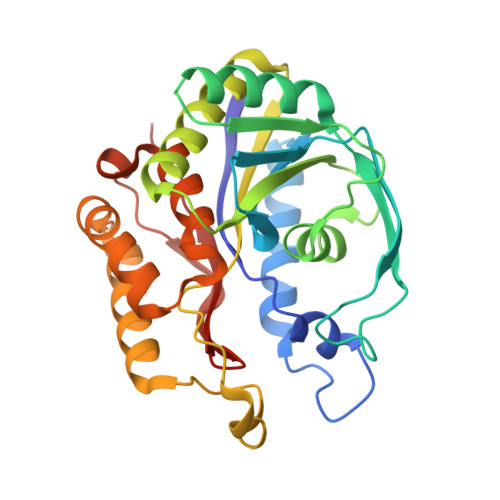Structure and biochemical characterization of an extradiol 3,4-dihydroxyphenylacetate 2,3-dioxygenase from Acinetobacter baumannii.
Pimviriyakul, P., Buttranon, S., Soithongcharoen, S., Supawatkon, C., Disayabootr, K., Watthaisong, P., Tinikul, R., Jaruwat, A., Chaiyen, P., Chitnumsub, P., Maenpuen, S.(2023) Arch Biochem Biophys 747: 109768-109768
- PubMed: 37769893
- DOI: https://doi.org/10.1016/j.abb.2023.109768
- Primary Citation of Related Structures:
8IQ8 - PubMed Abstract:
3,4-Dihydroxyphenylacetate (DHPA) 2,3-dioxygenase (EC 1.13.11.15) from Acinetobacter baumannii (AbDHPAO) is an enzyme that catalyzes the 2,3-extradiol ring-cleavage of DHPA in the p-hydroxyphenylacetate (HPA) degradation pathway. While the biochemical reactions of various DHPAOs have been reported, only structures of DHPAO from Brevibacterium fuscum and their homologs are available. Here, we report the X-ray structure and biochemical characterization of an Fe 2+ -specific AbDHPAO that shares 12% sequence identity to the enzyme from B. fuscum. The 1.8 Å X-ray structure of apo-AbDHPAO was determined with four subunits per asymmetric unit, consistent with a homotetrameric structure. Interestingly, the αβ-sandwiched fold of the AbDHPAO subunit is different from the dual β-barrel-like motif of the well-characterized B. fuscum DHPAO structures; instead, it is similar to the structures of non-DHPA extradiol dioxygenases from Comamonas sp. and Sphingomonas paucimobilis. Similarly, these extradiol dioxygenases share the same chemistry owing to a conserved 2-His-1-carboxylate catalytic motif. Structure analysis and molecular docking suggested that the Fe 2+ cofactor and substrate binding sites consist of the conserved residues His12, His57, and Glu238 forming a 2-His-1-carboxylate motif ligating to Fe 2+ and DHPA bound with Fe 2+ in an octahedral coordination. In addition to DHPA, AbDHPAO can also use other 3,4-dihydroxyphenylacetate derivatives with different aliphatic carboxylic acid substituents as substrates, albeit with low reactivity. Altogether, this report provides a better understanding of the structure and biochemical properties of AbDHPAO and its homologs, which is advancing further modification of DHPAO in future applications.
- Department of Biochemistry, Faculty of Science, Kasetsart University, Bangkok, 10900, Thailand.
Organizational Affiliation:

















